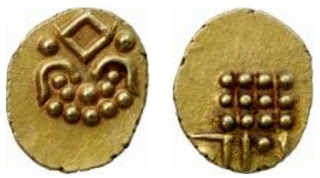Naiki Devi, a Goan princess was the regent queen of the Chalukya dynasty during her son Mulraja II's infancy from 1175 AD. She was the queen of king Ajayapala, the Chalukya Gujarat king who rose to the throne in 1171 AD, but died in 1175 AD.
Chalukyas of Gujarat, Drachm, 11th century
Naiki Devi, the Warrior Queen
Map of Chalukyas, 1150 AD.
Muhammad Ghori (the founder of the Delhi Sultanate in 1206 AD) invaded India and captured Multan in 1175 AD. Soon after, he led a major army to Uch (present day Pakistan) after marching down the Gumal / Gomal Pass. From there, he was able to traverse the desert and begin his journey towards Anhiwara (capital of Chalukya Kingdom). At that time, Gujarat and Rajasthan were part of Chalukya kingdom. Ghori was obviously confident that the Chalukyas were susceptible to invasion since they lacked a monarch. Besides he considered the queen as weak and easy to conquer.
Naiki Devi remained undaunted about the possibility of an invasion of her kingdom by the marauding forces of Ghori. She decided to throw herself completely into strategizing a well-conceived opposition to the invading hordes. She also opened diplomatic channels seeking support from neighbouring kingdoms for help including to the court of chivalrous Prithviraj Chauhan who held sway over large parts of what is today's Delhi, Haryana, Rajasthan and even parts of Punjab, Uttar Pradesh and Madhya Pradesh. However, unfortunately for reasons best known to them, none of them including Chauhan, seemed to share the foresight of Naina Devi in forging an alliance against the recurring menace. It was left for her to garner the support of the vassal state of the Chalukyas, the clans of the Naddula Chahamanas, the Jalor Chahamanas and the Parmaras. Naiki Devi realised that in terms of size and strength this ragtag confederacy was no match to Ghori's superior army. She had to plan out her strategy that would help her even against the odds that were stacked against her.
Quite like her ancestor Bhimdeva I, who had drawn the forces of Sultan Mahmud of Ghazni to a battleground of his choice, Naika Devi planned the conquest against the Ghorid armyin the rugged terrain of Gadaraghatta. This was an area at the foothills of Mount Abu, near the village of Kasahrada (in today's Sirohi district). The narrow hill passes there, and the terrain was completely unfamiliar to the invaders. When the armies of Muhammad Ghori made their way towards Kasahrada, the Queen made a frontal attack on them.
The Battle of Kasahrada of 1178 AD. At the foot of Mt Abu, the Ghurid army confronted the combined army of Chalukya feudatories, Parmaras of Abu, Chahamana of Nadol and Kirtipal from Jalor. According to Prabandha Kosha, the Ghurid army was led into the pass and closed the enemy retreat behind them. There was a frontal assault by the Chalukya army led by Naiki Devi leading with child Mulraja II who was 13 years old tied to her body. Through her strong combat skills, she cut down every invading soldier that came her way. An outnumbered army managed to crush the forces that had just vanquished the mighty Sultanate of Ghazni and thereafter the mighty Sultans of Multan.
The unexpected massive rout that befell his army shattered Muhammad Ghori's pride, more so since this defeat was wrought on him by a woman whom he had vastly underestimated. He fled from the battlefield with a handful of bodyguards to save his life.
Such was the rude jolt he received from this battle that he never again returned towards Gujarat and instead eyed Punjab, the following year. Gujarat remained invincible for Muhammad Ghori personally. Had this conquest been won by Ghori, the whole of southern Rajputana and Gujarat would have gone under his control and the history of India might have taken a different course.
Naiki Devi's epic victory finds echoes in the works of several local chroniclers. A Chakukyan inscription from the reign of Bhima II (Mularaja II's brother and successor) states that even a woman could defeat the Hammira during the reign of Bala Mularaja. The Muslim chroniclers too, have unabashedly mentioned the rout that Ghorid forces faced in Gujarat. Minhaj-i-Siraj states that in the Islamic year 574AH, (1178 AD) Mu'ízzud-Din ''marched towards Nahrwala by way of Uchchha and Multan. The Rae of Nahrwala was young in years, but had numerous forces, and when the battle took place, the army of Islam was defeated and put to rout, and the Sultan-i-Ghazi ( Muízzud-Din) returned without accomplishing his designs. The sixteenth century Badauni and later Ferishta wrote about the defeat of Ghori.
The silver Gadhaiya was the coin used in the region ruled by Chalukyas of Gujarat. These coins are attributed to the Indo-Sassanian dynasties and their successors. They were basically a degenerated copy of the Sassanian coinage with an impressionist type bust in front and a rather aspirational version of a fire altar in the reverse.
Chalukyas of Gujarat, 11th century AD, Drachm, weight 3.7 gm, Obverse: crude Indo-Sasanian style bust right, Reverse: Stylized fire altar.
Earlier Chalukya coins show a slow degenerated Indo-Sasanian style on both sides, over 500 years, till arriving at the Gadhiya paisa.
Chalukyas of Gujarat, 1030-1120 AD, silver, weight 4 gm, Obverse: Stylized Sassanian head to right, surmounted by crescent, Reverse: Fire altar, pelleted sun and crescent.
Chalukyas of Gujarat, Kumarapala, 1144 AD, gold pagoda, weight 3.9 gm.


























































